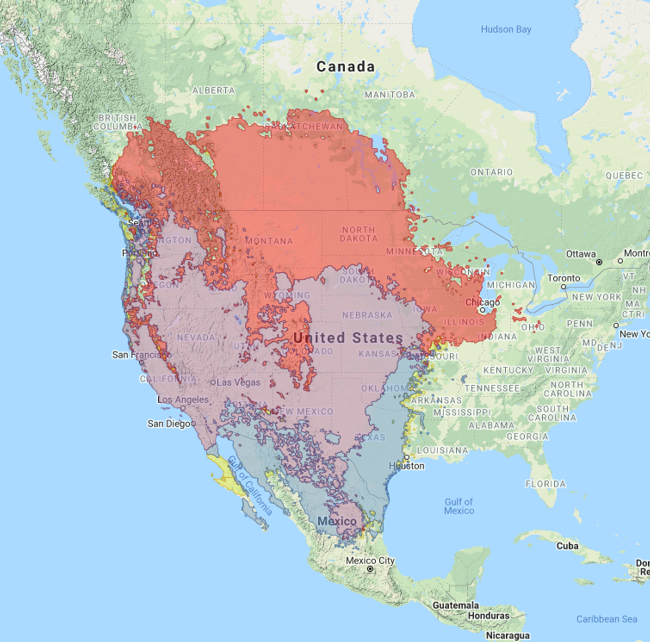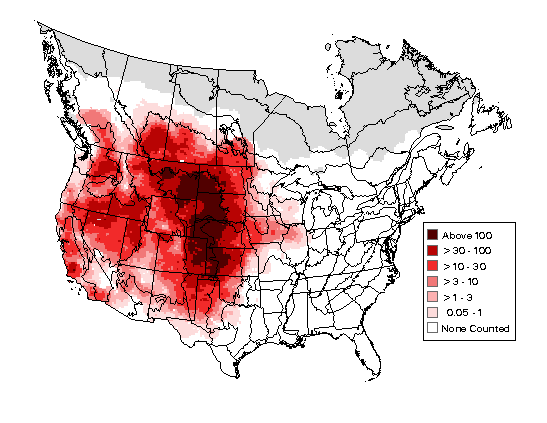Birdfinding.info ⇒ Common to locally abundant across much of western North America, especially on the Great Plains, where it is one of the most numerous and conspciuous breeding birds across most of the region (see Breeding Bird Survey Abundance Map in Notes below).
Western Meadowlark
Sturnella neglecta
Western and central North America.
Breeding. Breeds from late March to July in grasslands of the Great Plains, Great Basin, and other western biomes from central British Columbia, the prairie provinces, and western Great Lakes region south to Baja California and in the central plateau of Mexico to Guanajuato.
Breeds locally or sporadically north of its usual range in Canada and east to Lake Erie.
Nonbreeding. Winters from southwestern British Columbia, Idaho, Wyoming, Nebraska, and Iowa south to central Mexico (to Baja California Sur, Jalisco, Michoacán, and Tamaulipas), and east to Louisiana.
A few stragglers remain overwinter on the northern breeding grounds.
Movements. Northbound migration occurs mainly during March. Southbound migration begins in August and continues into November.
Regularly strays far east of usual range in both spring and fall to the St. Lawrence Valley and New England, casually to the Maritime provinces. Recorded less often along the Eastern Seaboard from the Mid-Atlantic to Florida—but presumably underreported due to difficulty of distinguishing it from the expected Eastern Meadowlark.
Recorded casually north to southeastern Alaska, the Liard River Valley, and northern Manitoba (Churchill); exceptionally to Kodiak Island, Cook Inlet, the interior of Alaska (Delta Junction), and the northern coast of the Yukon (Herschel Island) and Northwest Territories (Paulatuk).
Introductions. Introduced to several of the Hawaiian Islands in the 1920s and ‘30s as an experimental insect control measure. Bred successfully only on Kauai, where the population increased until the 1980s, then declined somewhat but remains established.
Identification
Familiar and readily identified as a meadowlark, but nearly identical to the various forms of Eastern Meadowlark. Both are robust, yellow-breasted, brown-backed songbirds with a prominent black V or U on the chest and a long, sharp-tipped, spike-like bill.
Adult meadowlarks in breeding plumage are vivid yellow from the throat to the belly. The sides and flanks are whitish with black or blackish streaks and spots. On Western the streaks tend to be boldest and darkest on the sides of the chest, then thinner, sparser, and browner on the flanks.

Western Meadowlark. (Antelope Island State Park, Utah; June 23, 2016.) © Jeff Maw
Breeding adult Western can often be identified by the extent of yellow on the face—the yellow on the throat typically extends up to include the whisker area, which is typically plain on Eastern. However, many individual Westerns have less extensive yellow, and some Easterns have a yellowish tinge on the whisker.
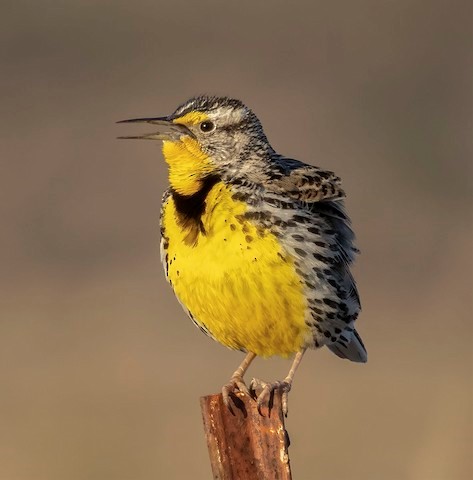
Western Meadowlark. (Ramona, California; January 21, 2021.) © Roger Uzun
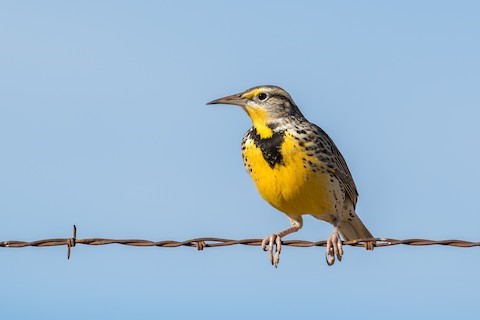
Western Meadowlark. (Santa Inez, California; November 23, 2017.) © Louis Bevier
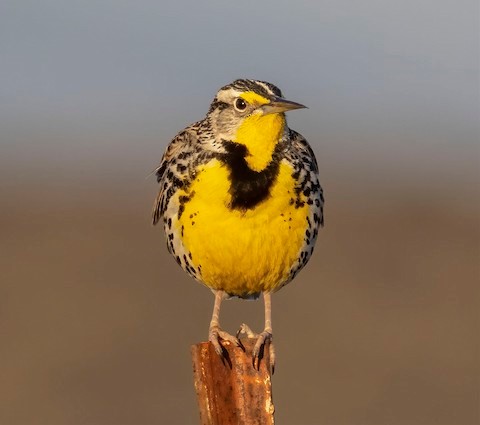
Western Meadowlark. (Ramona, California; January 21, 2021.) © Roger Uzun
The head is prominently marked. The crown is mostly blackish or dark-brown with a whitish central stripe and pale eyebrow that is yellow in front of the eye and whitish behind the eye. There is a dark eyeline that is indistinct in in front of the eye and much darker behind the eye. On Western the head markings tend to contrast less than on Eastern.
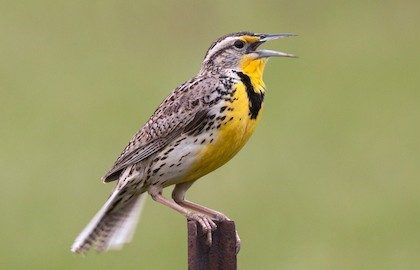
Western Meadowlark. (Farmington, California; April 20, 2020.) © Jim Gain
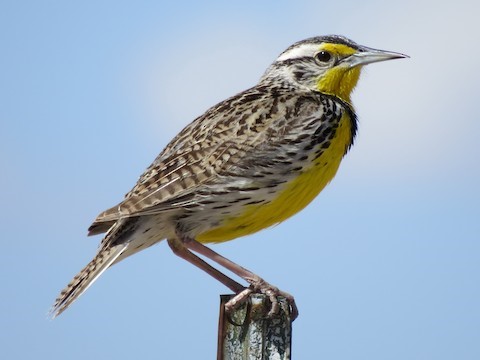
Western Meadowlark. (Valle del Oro National Wildlife Refuge, New Mexico; April 9, 2017.) © Dustin Johnston
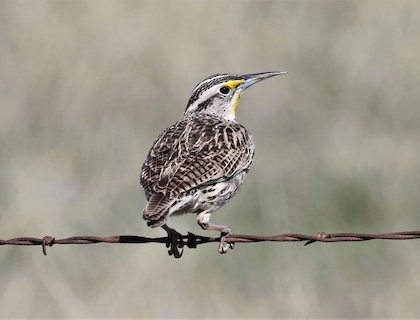
Western Meadowlark in breeding plumage with plain whisker. (Timpie Spring Wildlife Management Area, Utah; April 4, 2020.) © Max Malmquist

Western Meadowlark. (Pawnee National Grassland, Colorado; July 4, 2017.) © Margaret Viens
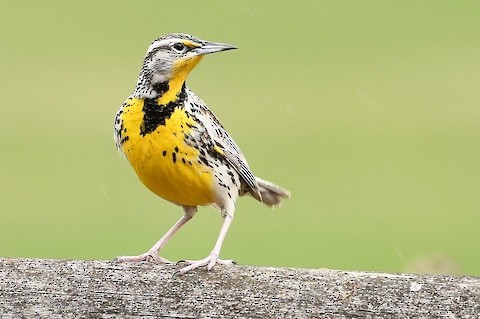
Western Meadowlark. (Hope Airport, British Columbia; March 28, 2018.) © Gord Gadsden

Western Meadowlark. (Valle del Oro National Wildlife Refuge, New Mexico; April 2, 2017.) © Dustin Johnston
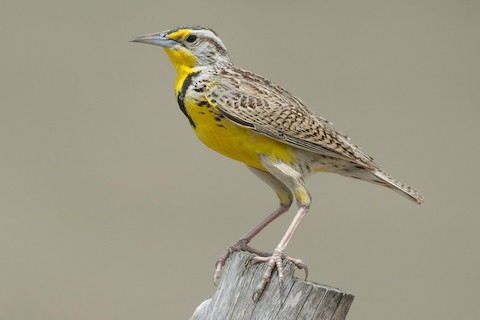
Western Meadowlark. (San José Magaña, Zaragoza, San Luis Potosí, Mexico; June 16, 2019.) © Juan Miguel Artigas Azas
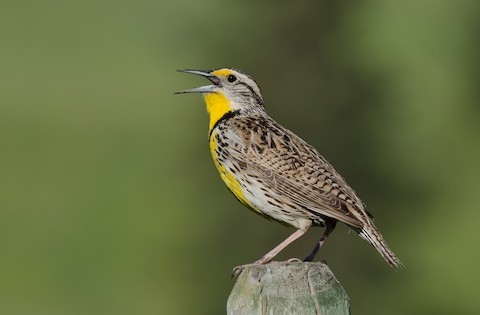
Western Meadowlark. (Lake Country, British Columbia; May 28, 2017.) © Alix d’Entremont
The upperparts are mostly brown with black or dark-brown bars and feather-centers. In general, Western has paler upperparts than most Easterns, although both species vary widely and the arid-land forms of Eastern (especially “Lilian’s” but also hoopesi) are paler than most Westerns.
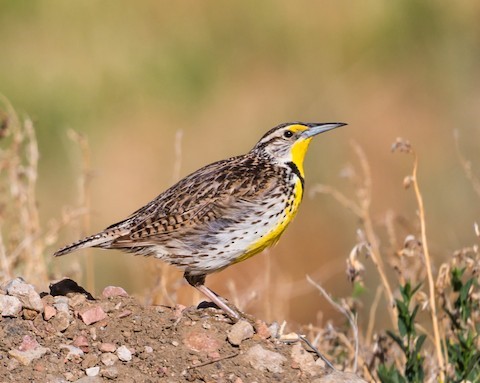
Western Meadowlark. (Cross Creek Regional Park, Fountain, Colorado; May 23, 2020.) © Jim Merritt

Western Meadowlark. (Kingfisher Trail, Deer Flat National Wildlife Refuge, Idaho; March 10, 2020.) © Ceredig Roberts
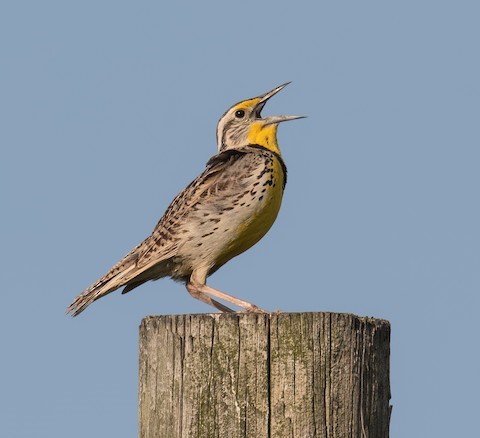
Western Meadowlark, singing from a fencepost—note the sparse streaking and limited yellow apparent when viewed from the side. (Adam Grimm Prairie, Ottawa National Wildlife Refuge, Ohio; June 28, 2018.) © Darlene Friedman
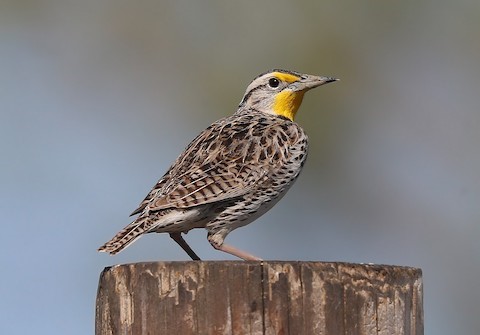
Western Meadowlark. (Yolo Bypass Wildlife Area, Davis, California; April 1, 2017.) © Matt Davis
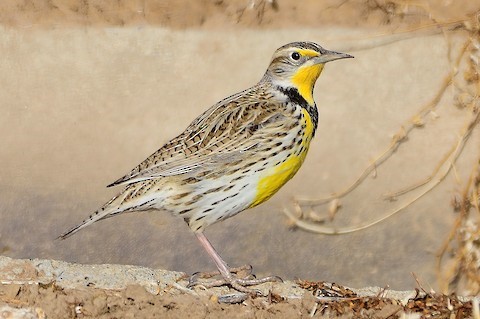
Western Meadowlark. (Bosque del Apache National Wildlife Refuge, New Mexico; December 12, 2020.) © Ad Konings
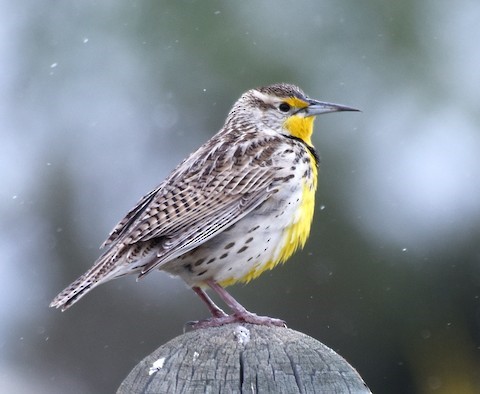
Western Meadowlark. (Union Reservoir, Longmont, Colorado; April 30, 2017.) © Steven Mlodinow
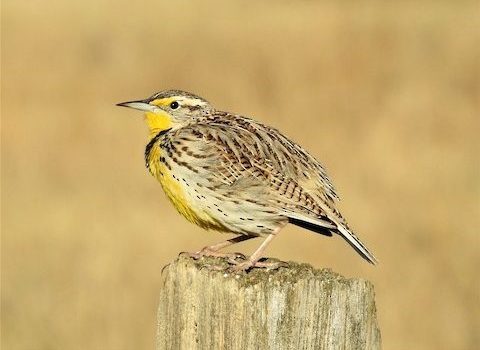
Western Meadowlark. (Fly Creek Road, Big Horn County, Montana; March 29, 2020.) © Jan Thom

Western Meadowlark. (Lake Country, British Columbia; April 14, 2019.) © Nick Swan
When seen from above, the tail is mostly brown and barred. However, the outer three tail feathers are mostly white, which is visible mostly when the tail is spread. Western’s tail tends to be paler brown and less heavily marked, with less extensive white on the outer feathers than Eastern.
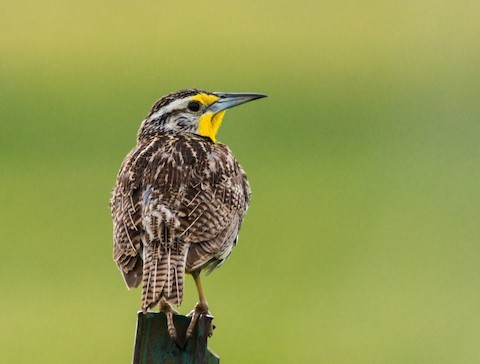
Western Meadowlark. (Fountain, Colorado; June 19, 2020.) © Jim Merritt
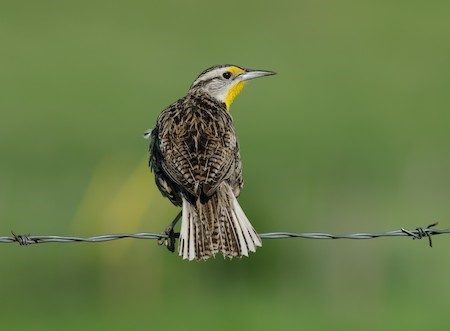
Western Meadowlark. (Lake Country, British Columbia; May 28, 2017.) © Alix d’Entremont

Western Meadowlark. (Coalton Open Space, Superior, Colorado; March 26, 2017.) © Ted Floyd

Western Meadowlark. (Tolo Lake, Idaho; April 2, 2017.) © Craig Johnson
Nonbreeding adults generally resemble breeding adults, but appear duller and mostly paler overall, with weaker markings.
Immatures generally resemble nonbreeding adults, but are more uniformly colored in shades of buff and brown. They also vary and most are probably indistinguishable by sight from the various forms of Eastern.
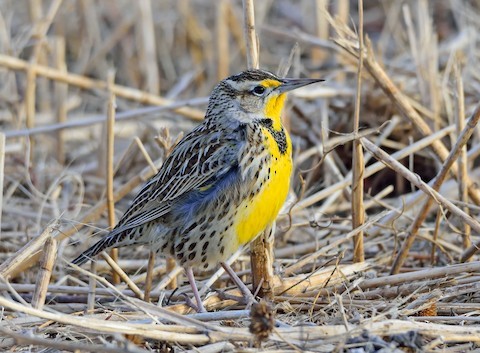
Western Meadowlark, nonbreeding plumage. (Bosque del Apache National Wildlife Refuge, New Mexico; December 30, 2019.) © Ad Konings
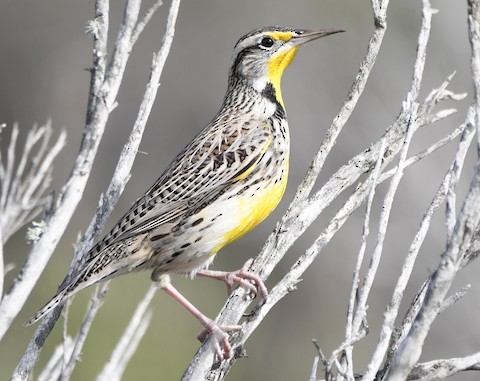
Western Meadowlark, nonbreeding plumage. (University of California, Santa Barbara Campus, Isla Vista, California; January 8, 2017.) © Alan Prichard
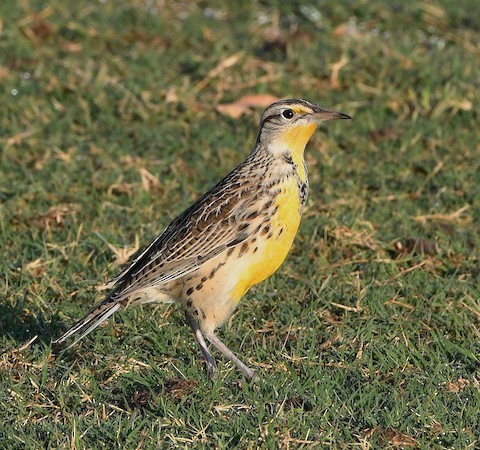
Western Meadowlark, nonbreeding plumagek. (Silverlake Park, Tucson, Arizona; October 21, 2020.) © David Beaudette
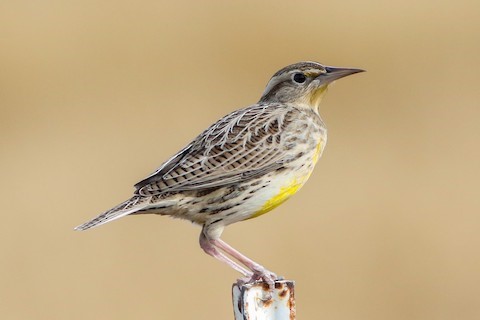
Western Meadowlark, nonbreeding plumage. (Granger Lake, Texas; December 2, 2016.) © Byron Stone
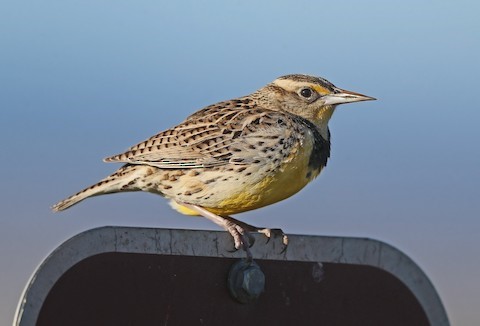
Western Meadowlark, nonbreeding plumage. (Sacramento National Wildlife Refuge, California; February 3, 2018.) © Matt Davis

Western Meadowlark, nonbreeding plumage. (Helena, Montana; October 26, 2020.) © Sharon Dewart-Hansen
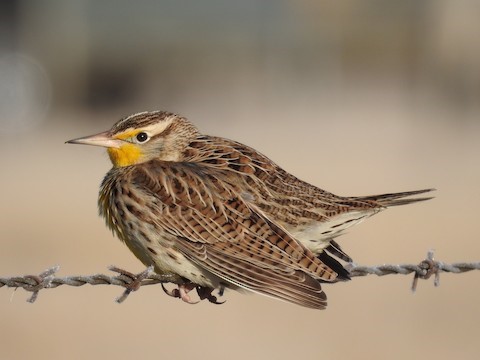
Western Meadowlark, nonbreeding plumage. (Graford, Texas; December 14, 2020.) © Kevin S. Long
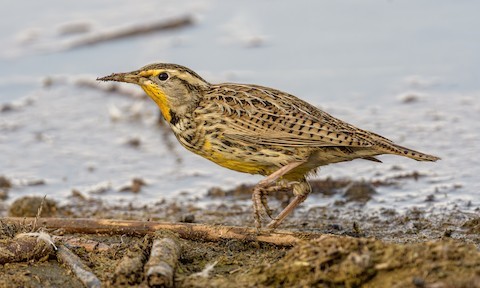
Western Meadowlark, nonbreeding plumage. (Merced National Wildlife Refuge, California; November 12, 2019.) © Rebecca Matsubara
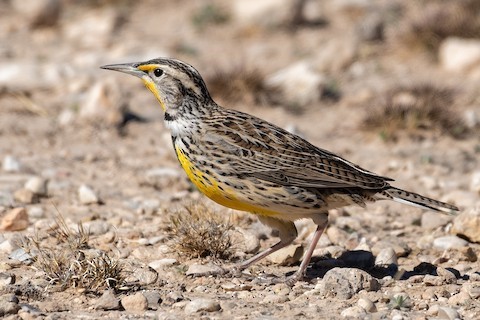
Western Meadowlark, nonbreeding plumage. (Rattlesnake Springs, Carlsbad Caverns National Park, New Mexico; January 31, 2019.) © Don Danko
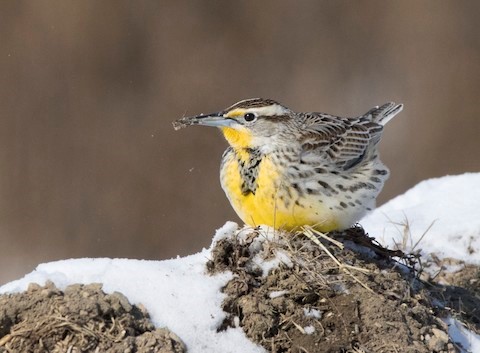
Western Meadowlark, nonbreeding plumage. (Swift Current, Saskatchewan; March 9, 2017.) © Nick Saunders
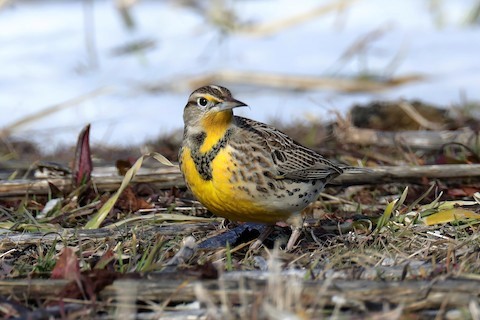
Western Meadowlark, nonbreeding plumage. (Bradford Farm, Boone County, Missouri; January 19, 2021.) © Doug Hommert
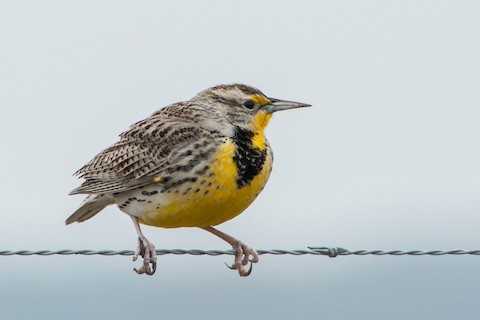
Western Meadowlark, nonbreeding plumage. (Markham, Texas; March 9, 2014.) © Byron Stone

Western Meadowlark, nonbreeding plumage. (Sacaton Sewage Treatment Plant, Arizona; October 17, 2018.) © David Pearson
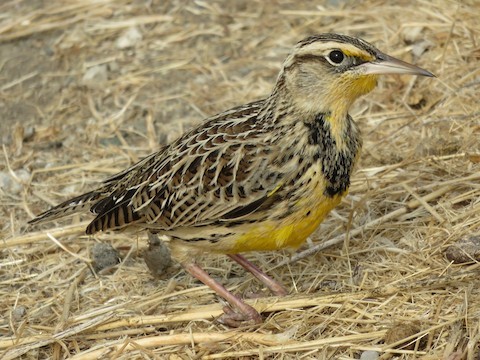
Western Meadowlark, nonbreeding plumage. (Nob Hill Pond, Redwood Shores, California; October 17, 2017.) © Kent Forward
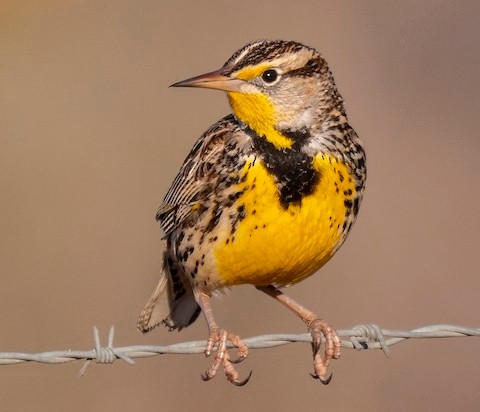
Western Meadowlark, nonbreeding plumage. (Rangeland Road, Ramona, California; November 15, 2019.) © Roger Uzun
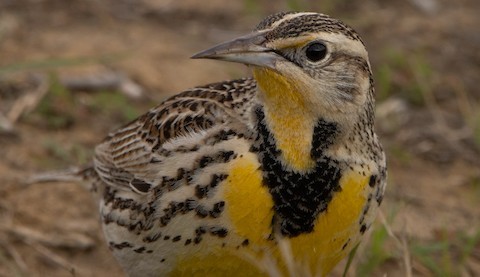
Western Meadowlark, nonbreeding plumage. (Sacramento National Wildlife Refuge, California; February 3, 2021.) © Liam Huber

Western Meadowlark, immature. (Guymon, Oklahoma; November 15, 2020.) © Van Remsen
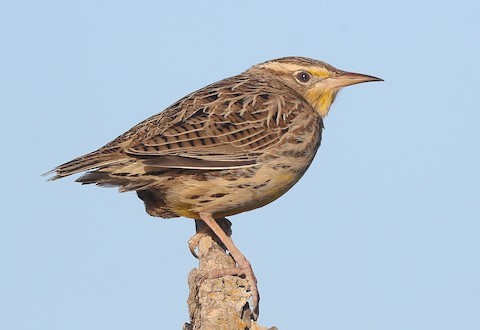
Western Meadowlark, immature. (Colusa National Wildlife Refuge, California; October 13, 2018.) © Matt Davis

Western Meadowlark, immature. (Hagerman National Wildlife Refuge, Texas; February 15, 2020.) © Geoff Hill
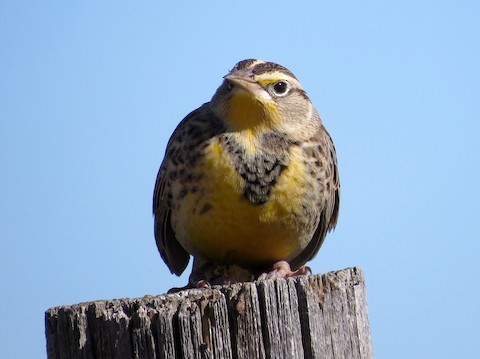
Western Meadowlark, immature. (Lincoln County, Colorado; October 7, 2017.) © Todd Deininger

Western Meadowlark, immature. (Donner Camp Picnic Area, Truckee, California; October 24, 2020.) © Matt Davis
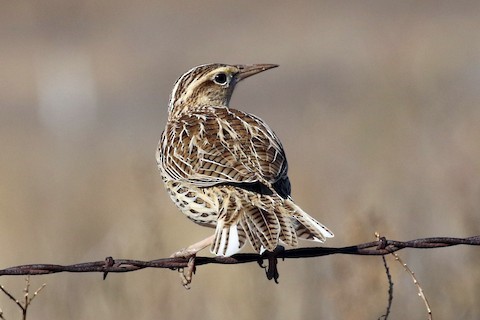
Western Meadowlark, immature, showing extensively white outer tail feathers. (Rural Route 1832, Balmorhea, Texas; December 6, 2015.) © Dan Jones
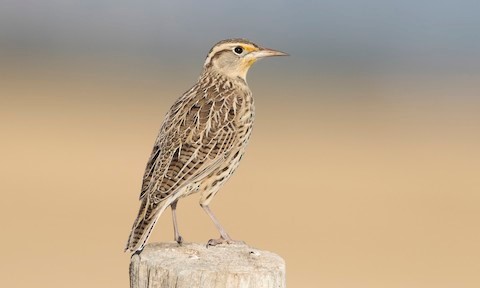
Western Meadowlark, immature. (Big Horn, Wyoming; October 6, 2015.) © Brian Sullivan
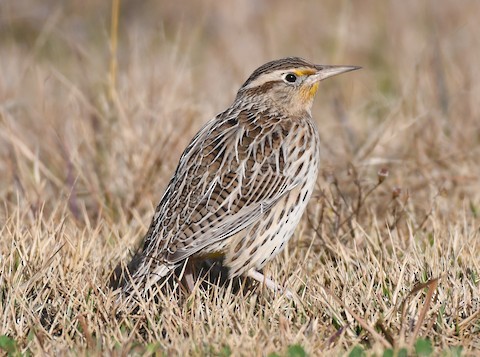
Western Meadowlark, immature. (Sims Lane, Brazos County, Texas; November 23, 2019.) © Simon Kiacz
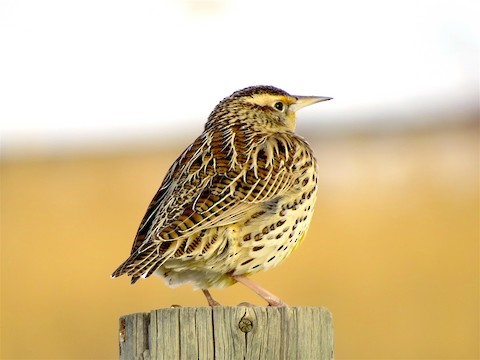
Western Meadowlark, immature. (Prince Reservoir #2, Lafayette, Colorado; January 8, 2017.) © Ted Floyd

Western Meadowlark, immature. (Sacramento, California; July 4, 2018.) © Stephen Fettig
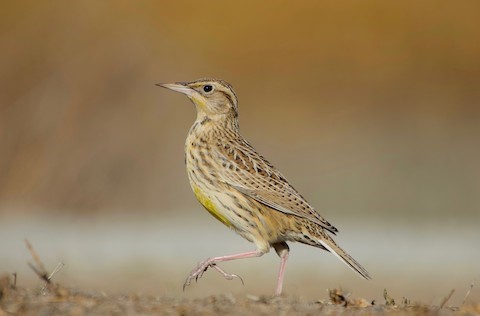
Western Meadowlark, immature. (Byxbee Park, Palo Alto, California; November 28, 2020.) © Carter Gasiorowski

Western Meadowlark, immature. (Lake Tamarisk, Desert Center, California; October 9, 2020.) © Eric VanderWerf

Western Meadowlark, immature. (Vernon, Texas; November 10, 2020.) © Van Remsen
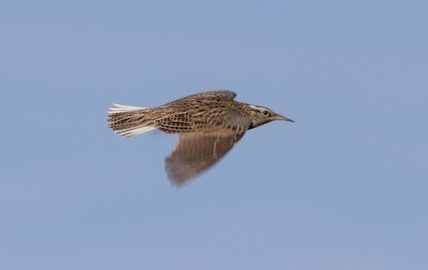
Western Meadowlark, showing broadly white outer tail feathers. (Barr Lake State Park, Colorado; February 2, 2021.) © Lorraine Lanning
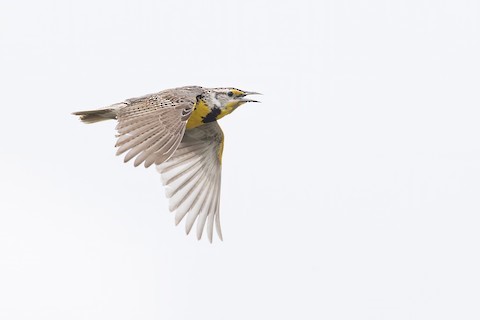
Western Meadowlark. (Fowler, Indiana; June 28, 2020.) © Ryan Sanderson
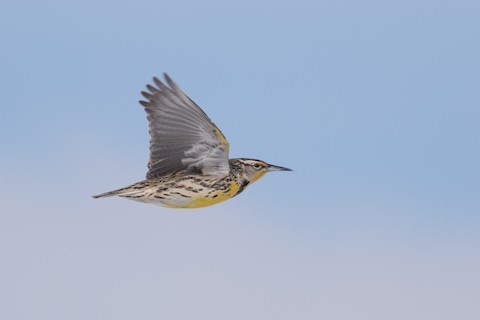
Western Meadowlark. (Hells Gate State Park, Idaho; January 16, 2017.) © Jesse Amesbury
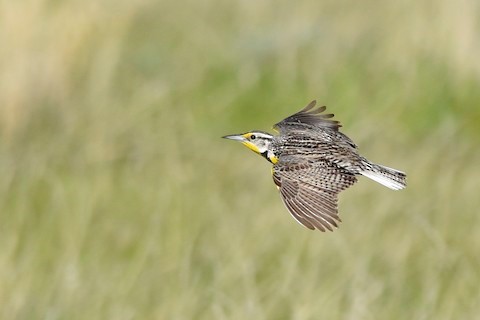
Western Meadowlark, showing broadly white outer tail feathers. (Red Lodge, Montana; June 1, 2019.) © Daniel Irons
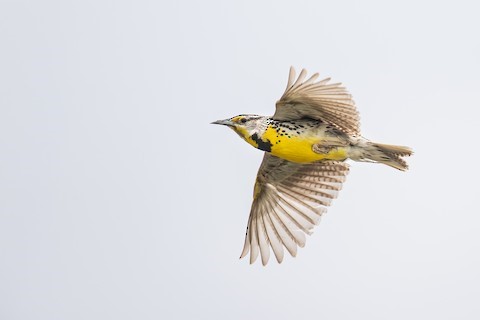
Western Meadowlark. (Fowler, Indiana; June 28, 2020.) © Ryan Sanderson

Western Meadowlark. (Pacific Commons Linear Park, Fremont, California; November 11, 2018.) © J. Tanner
Cf. Eastern Meadowlark. Western and Eastern Meadowlarks overlap broadly across much of North America and are so similar as to be visually indistinguishable without a close study—which sometimes requires details about the location, season, sex, and age of a given individual. Much of the confusion stems from variability among Eastern’s populations, especially in the southwestern U.S. and northern Mexico, where “Lilian’s Meadowlark” and the unusual hoopesi subspecies (sometimes grouped with “Lilian’s”) complicate the picture. However, individual variation within typical Eastern and Western populations is strong enough that they overlap in all the plumage features traditionally used to identify them.
Despite the subtleties and similarities, most closely observed adult meadowlarks are distinguishable by plumage, and nearly all can be identified by voice. Considering the importance of voice in identification, it seems significant that vocal distinctions appear to be consistent across all Eastern populations—despite its divergent appearance, “Lilian’s” sounds like typical Easterns.
Songs: Western’s song is more complex, richer, and more musical than Eastern’s. Western almost always ends with an accelerating rush of notes. Although each song-type is more elaborate, each individual Western tends to vary its songs much less than individual Easterns. Peculiarly, however, song alone can be unreliable because it is not innate. Some meadowlarks have been observed singing songs typical of the other species—usually mixing elements of both.
Calls: Western often gives a low but sharp chup! or plipt! call that Eastern does not. Other calls typical of Western include a long, evenly paced rattle and a strong, clear whistle. Eastern’s most typical calls are a buzzy dzzzt! dzzzt!, not similar to any Western calls.
Whisker Color: One of the field marks traditionally cited to distinguish Eastern and Western Meadowlarks is the color of the whisker area below the eyeline. On adult Westerns this area is typically yellow like the throat, whereas adult Easterns have a plain whitish whisker streak between the dark eyeline and the yellow throat. This distinction is most useful on typical adult male Westerns, which tend to appear all-yellow below the eyeline. However, many Westerns have plain whiskers and many Easterns show some yellow in this area, so it is often unreliable.
Head Stripes: Another typical but unreliable distinction is the darkness and boldness of the eyestripe and crown stripes. In general, Eastern has blackish head markings whereas Western has brown head markings. This distinction can be useful but there is an overlap between them and many ambiguous cases. Some Westerns show darker-than-average head markings and some Easterns have brownish markings.
Flank Streaks: Typical Eastern has strong, blackish streaks on its flanks, whereas Western typically has blackish streaks on its sides (beside the chest) but paler, thinner, sparser streaks or spots on the flanks. As in other plumage pattern features, both Eastern and Western vary internally and they overlap.
Tail Pattern: The tails of Western and Eastern tend to differ slightly in both the central brown feathers and the white outer feathers—although individual variation makes these differences less reliable than some sources suggest. In general, Western has paler central feathers and more limited white on the outer feathers. Conversely, Eastern tends to have darker central feathers and more extensively white outer feathers.
Southwestern Easterns: The most confusing forms of Eastern are “Lilian’s” (lilianae), which occurs from Arizona to western Texas and in the adjacent states of Mexico, and hoopesi, which inhabits southern Texas and northeastern Mexico. By voice these forms are both Eastern, but their plumages differ from other populations. Lilianae is paler overall than Western, and has the most extensively white outer tail feathers of all meadowlarks. Hoopesi has approximately the same overall coloration as Western—except that its tail pattern and whisker color are more consistent with Eastern, as described above.
Immatures: Immature Western and Eastern Meadowlarks are more similar overall than adults. In some cases, the distinctions that apply to adults may also be useful with immatures.
Notes
Polytypic species consisting of two recognized subspecies.
References
Alderfer, J., and J.L. Dunn. 2014. National Geographic Complete Birds of North America (Second Edition). National Geographic Society, Washington, D.C.
BirdLife International. 2018. Sturnella neglecta. The IUCN Red List of Threatened Species 2018: e.T22724256A132173994. https://dx.doi.org/10.2305/IUCN.UK.2018-2.RLTS.T22724256A132173994.en. (Accessed February 1, 2021.)
eBird. 2021. eBird: An online database of bird distribution and abundance. Cornell Lab of Ornithology, Ithaca, N.Y. http://www.ebird.org. (Accessed February 1, 2021.)
Howell, S.N.G., and S. Webb. 1995. A Guide to the Birds of Mexico and Northern Central America. Oxford University Press.
Jaramillo, A., and P. Burke. 1999. New World Blackbirds: The Icterids. Princeton University Press, Princeton, N.J.
Salt, W.R., and J.R. Salt. 1976. The Birds of Alberta. Hurtig Publishers, Edmonton, Alberta.
Sibley, D.A. 2000. The Sibley Guide to Birds. Alfred A. Knopf. New York.
Xeno-Canto. 2021. Western Meadowlark – Sturnella neglecta. https://www.xeno-canto.org/species/Sturnella-neglecta. (Accessed February 1, 2021.)

